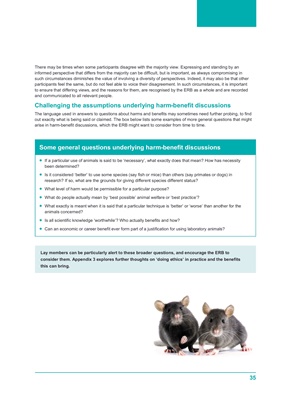
35
There may be times when some participants disagree with the majority view. Expressing and standing by an
informed perspective that differs from the majority can be difficult, but is important, as always compromising in
such circumstances diminishes the value of involving a diversity of perspectives. Indeed, it may also be that other
participants feel the same, but do not feel able to voice their disagreement. In such circumstances, it is important
to ensure that differing views, and the reasons for them, are recognised by the ERB as a whole and are recorded
and communicated to all relevant people.
Challenging the assumptions underlying harm-benefit discussions
The language used in answers to questions about harms and benefits may sometimes need further probing, to find
out exactly what is being said or claimed. The box below lists some examples of more general questions that might
arise in harm-benefit discussions, which the ERB might want to consider from time to time.
Some general questions underlying harm-benefit discussions
If a particular use of animals is said to be "necessary", what exactly does that mean? How has necessity
been determined?
Is it considered "better" to use some species (say fish or mice) than others (say primates or dogs) in
research? If so, what are the grounds for giving different species different status?
What level of harm would be permissible for a particular purpose?
What do people actually mean by "best possible" animal welfare or "best practice"?
What exactly is meant when it is said that a particular technique is "better" or "worse" than another for the
animals concerned?
Is all scientific knowledge "worthwhile"? Who actually benefits and how?
Can an economic or career benefit ever form part of a justification for using laboratory animals?
Lay members can be particularly alert to these broader questions, and encourage the ERB to
consider them. Appendix 3 explores further thoughts on "doing ethics" in practice and the benefits
this can bring.